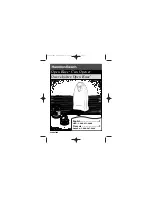
13
DESCRIPTION OF THE LEDs
RED LEDs should be switched off. Indication of faults to be rectified;
this does not apply to failsafe photocells not connected. (see
“photocell” description)
(Example: short circuit, photocells and/or contact strip)
POINT
DESCRIPTION
LED A
RED Learn/Delete radio channel 1
LED B
RED Start impulse channel 1
LED C
RED Learn/Delete radio channel 2
LED D
RED Start impulse channel 2
LED E
RED photocell active for OPEN
LED F
RED photocell active for CLOSE
LED G
RED photocell active for CLOSE
LED H
RED contact strip
LED I
GREEN stop
LED J
YELLOW limit switch gate OPEN
LED K
YELLOW limit switch gate CLOSED
LED L
RED learn program (distance covered)
CONTROL BOX CONFIGURATION
POINT DESCRIPTION
FUNCTION
1
M1, terminals:1,2,3
230 to 240 vac ~
2
M2, terminals:4,5,6
Drive
3
M3, terminals:7,10
Input trigger (1) normally open
Terminals:8,10
Input trigger (2) normally open
Terminals:9,10
Emergency-stop push-button (NC)
must be bridged if no switch
connected
Terminals:11,12
Gate monitor/lighting
Terminals:12,13
Flashing lamp
Terminals:14,15
Connection for accessories 24Vdc
4
M4, terminals:16,19
Normally open PE input
Terminals:17,19
Normally closed PE input
Terminals:18,19
Normally closed (main PE) input
Terminals:20,21
Contact strip 8.2 kilo ohms
Terminals:22,23
Antenna
5
CN4/CN5, connector Radio module sockets
6
CH1, pushbutton
Learn/Delete radio channel 1
7
CH2, pushbutton
Learn/Delete radio channel 2
8
L1, pushbutton
Learning the distance covered
9
JMP1, jumper
Function selector for PE beam
NO/NC safe/secure
10
DIP1
Dip switch block
11
PT4, potentiometer
RPM sensor setting
12
PT3, potentiometer
Force setting
13
PT2, potentiometer
Automatic closing
14
PT1, potentiometer
Brake
15
CN2, connector
Magnetic limit switch
16
CN3, connector
RPM sensor
17
CN1, connector
E-lock






































